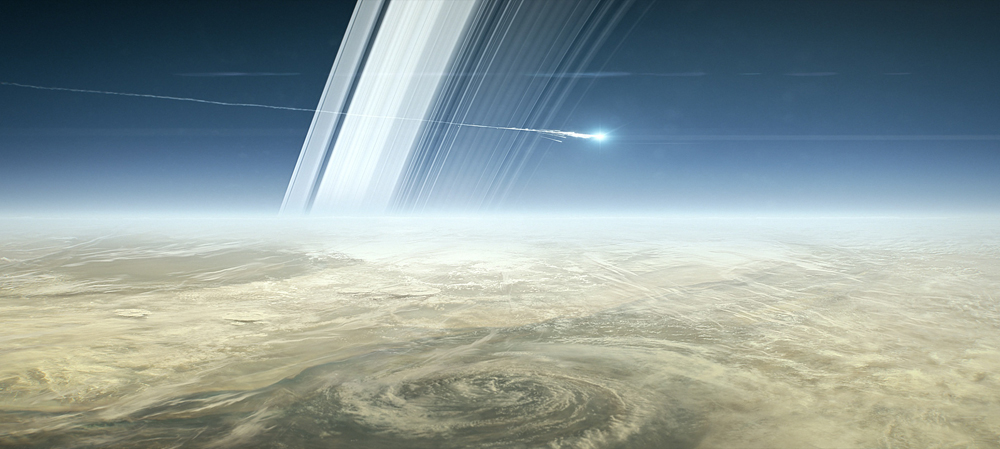Cassini Dives Into Saturn Today: Here's When and How to Watch

Today (Sept. 15), NASA's Cassini spacecraft will dive into Saturn's atmosphere and disintegrate. You can watch the action live right here on Space.com, starting at 4:00 a.m. PDT (7 a.m. EDT).
The intentional crash is expected to begin at about 4:55 a.m. PDT (7:55 a.m. EDT, 1155 GMT). Scientists at NASA's Jet Propulsion Laboratory (JPL) in California will monitor the descent and collect data from Cassini during the 1 to 2 minutes before the friction and heat from the fall destroy the spacecraft.
NASA's coverage of the event will begin at 4 a.m. PDT (7 a.m. EDT, 1100 GMT), and you can watch it on the Space.com home page, or on our watch-live page, courtesy of NASA. The coverage will include commentary on the end-of-mission activities and an uninterrupted live stream of the JPL mission control center. You can also watch via NASA TV. [Cassini at Saturn in Videos: Latest Mission Events and Amazing Discoveries]
At 6:30 a.m. PDT (9:30 a.m. EDT, 1330 GMT) NASA will host a post-mission news conference from JPL. You can also watch that event live here on Space.com.
"We'll be saddened — there's no doubt about it — at the loss of such an incredible machine," Earl Maize, the Cassini program manager, said during a news conference Wednesday (Sept. 13). "But I think all of us [on the Cassini team] have a great sense of pride … We set out to do something at Saturn, we did it [and] we did it extremely well."
The $3.26 billion Cassini-Huygens mission — a joint effort of NASA, the European Space Agency and the Italian Space Agency — launched toward Saturn in 1997 and arrived at the system in 2004. The Huygens lander separated from Cassini and plopped down on the surface of Saturn's moon Titan shortly after the arrival. The Cassini probe was scheduled to study the Saturn system until 2008, but the mission was given two extensions that stretched its lifetime into 2017.
Now, the probe is nearly out of fuel, and the mission must end. By sending Cassini into Saturn, scientists hope to gather a few bits of in-situ data from the atmosphere of one of the solar system's gas giants. Since April, Cassini has been making a series of loops between Saturn and the planet's innermost rings, "dipping its toe" into Saturn's atmosphere, according to mission scientists.
Get the Space.com Newsletter
Breaking space news, the latest updates on rocket launches, skywatching events and more!
The crash into Saturn's atmosphere will also ensure that Cassini will not collide with one of the Saturnian moons that researchers think could be habitable. Such a collision could risk contaminating those moons with microbes from Earth.
Amazing discoveries
Cassini's observations of the Saturn system resulted in a long roster of new discoveries, including observations of disturbances and changing features in the planet's rings, and revelations about the potential habitability of some of the system's moons. The spacecraft has taken 453,048 images of the Saturn system during its lifetime, and 3,948 scientific papers have been written based on Cassini data, according to NASA's most recent numbers.
The mission also opened up new mysteries that scientists will now have to investigate without the spacecraft, such as how the planet's magnetic field is generated (the prevailing theory doesn't seem to match up with observations), how quickly the planet's solid core rotates (which should determine the official length of a Saturn day), and how material from the planet's rings mixes with its atmosphere.
"Not only do we have an environment [at Saturn] that is just overwhelming in its abundance of scientific mysteries and puzzles, we got a spacecraft and a team that could exploit it," Maize said. "It's just been an amazing, amazing mission."
Follow Calla Cofield @callacofield. Follow us @Spacedotcom, Facebook and Google+. Original article on Space.com.
Join our Space Forums to keep talking space on the latest missions, night sky and more! And if you have a news tip, correction or comment, let us know at: community@space.com.

Calla Cofield joined Space.com's crew in October 2014. She enjoys writing about black holes, exploding stars, ripples in space-time, science in comic books, and all the mysteries of the cosmos. Prior to joining Space.com Calla worked as a freelance writer, with her work appearing in APS News, Symmetry magazine, Scientific American, Nature News, Physics World, and others. From 2010 to 2014 she was a producer for The Physics Central Podcast. Previously, Calla worked at the American Museum of Natural History in New York City (hands down the best office building ever) and SLAC National Accelerator Laboratory in California. Calla studied physics at the University of Massachusetts, Amherst and is originally from Sandy, Utah. In 2018, Calla left Space.com to join NASA's Jet Propulsion Laboratory media team where she oversees astronomy, physics, exoplanets and the Cold Atom Lab mission. She has been underground at three of the largest particle accelerators in the world and would really like to know what the heck dark matter is. Contact Calla via: E-Mail – Twitter









